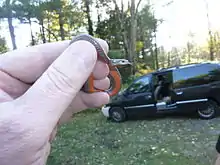| Northern redbelly snake | |
|---|---|
 | |
| Scientific classification | |
| Domain: | Eukaryota |
| Kingdom: | Animalia |
| Phylum: | Chordata |
| Class: | Reptilia |
| Order: | Squamata |
| Suborder: | Serpentes |
| Family: | Colubridae |
| Genus: | Storeria |
| Species: | |
| Subspecies: | S. o. occipitomaculata |
| Trinomial name | |
| Storeria occipitomaculata occipitomaculata (Storer, 1839) | |
| Synonyms | |
The northern redbelly snake (Storeria occipitomaculata occipitomaculata) is a nonvenomous snake in the family Colubridae, a subspecies of Storeria occipitomaculata. It is native to North America.
Geographic range
S. o. occipitomaculata is found in the central and northeastern United States and in adjacent southeastern Canada.[1]
Description
Adults and young of S. o. occipitomaculata have known dorsal colorations of solid olive-brown, tan-brown, chestnut-brown, grey-brown, grey or even black. They have three yellow spots posterior to the head shields,[2] to which the specific name occipitomaculata (meaning spotted back of the head) refers. The underside is coral-red to brick-red. Coloration is usually made up of three different shades forming a striped pattern. Like all species of the genus Storeria, the northern redbelly snake has keeled dorsal scales and no loreal scale.[3] Some specimens have been found with three black dots on the top of the head. Adults grow to 20–28 cm (7.9–11.0 in) in total length.[4]

Habitat
The northern redbelly snake lives in moist flowerbeds, gardens, and moist woodlands, such as borders between forest and wetlands. It often rests under logs and rocks near a woods or forest.[5]
Diet
S. o. occipitomaculata preys primarily on slugs and earthworms.[3]
Reproduction
The northern redbelly snake gives birth to live young.[3] Each newborn measures about 7.1–11 centimetres (2.8–4.3 in) in total length.[6]
In captivity
S. o. occipitomaculata is known to live up to four years in captivity. They will not attempt to bite when handled, but may curl back their upper "lip", and may emit musk from glands at the base of the tail.[4]
References
- ↑ Powell, R.; Conant, R.; Collins, J.T. (2016). Peterson Field Guide to Reptiles and Amphibians of Eastern and Central North America, Fourth Edition. Boston and New York: Houghton Mifflin Harcourt. xiv + 494 pp., 207 Figures, 47 color plates. (Storeria o. occipitomaculata, pp. 424–426, Figure 194, Plate 42).
- ↑ Boulenger, G.A. (1893). Catalogue of the Snakes in the British Museum (Natural History). Volume I., Containing the Families ... Colubridæ Aglyphæ, part. London: Trustees of the British Museum (Natural History). (Taylor and Francis, printers). xiii + 448 pp. + Plates I–XXVIII. (Ischnognathus occipitomaculatus, pp. 287–288).
- 1 2 3 Schmidt, K.P., and D.D. Davis. (1941). Field Book of Snakes of the United States and Canada. New York: G.P. Putnam's Sons. 365 pp. (Storeria occipitomaculata, pp. 229–230, Figure 74).
- 1 2 "Northern Redbelly Snake". Connecticut Department of Energy & Environmental Protection. Retrieved Aug 20, 2023.
- ↑ Wright AH & Wright AA (1957).
- ↑ "Northern Red-bellied Snake". HRM (Herpetological Resource and Management). Retrieved Aug 20, 2023.
Further reading
- Behler JL, King FW (1979). The Audubon Society Field Guide to North American Reptiles and Amphibians. New York: Knopf. 743 pp. ISBN 0-394-50824-6. (Storeria occipitomaculata, pp. 655–656 + Plates 501, 505–506).
- Conant R (1975). A Field Guide to Reptiles and Amphibians of Eastern and Central North America, Second Edition. Boston: Houghton Mifflin. xviii + 429 pp. ISBN 0-395-19979-4 (hardcover), ISBN 0-395-19977-8 (paperback). (Storeria occipitomaculata, p. 156 + Plate 22 + Map 127).
- Conant R, Bridges W (1939). What Snake Is That?: A Field Guide to the Snakes of the United States East of the Rocky Mountains. (Illustrations by Edmond Malnate). New York and London: D. Appleton-Century. Frontispiece map + 163 pp. + Plates A-C, 1–32. ("Storeria occipito-maculata", pp. 110–111 + Plate 21, Figure 61).
- Morris PA (1948). Boy's Book of Snakes: How to Recognize and Understand Them. A volume of the Humanizing Science Series, edited by Jaques Cattell. New York: Ronald Press. viii + 185 pp. ("The Red-Bellied Snake", Storeria o. occipitomaculata, pp. 28–29, 180).
- Smith HM, Brodie ED Jr. (1982). Reptiles of North America: A Guide to Field Identification. New York: Golden Press. 240 pp. ISBN 0-307-13666-3. (Storeria occipitomaculata, pp. 160–161).
- Storer, DH (1839). Reports on the Fishes, Reptiles and Birds of Massachusetts. Boston: Commissioners on the Zoological and Botanical Survey of the State. xii + 426 pp. ("C[oluber]. occipito-maculatus", new species, p. 230).
- Wright AH, Wright AA (1957). Handbook of Snakes of the United States and Canada. Ithaca and London: Comstock. 1,105 pp. (in 2 volumes). (Storeria o. occipitomaculata, pp. 714–721 + Figure 210 + Map 54).
- Zim HS, Smith HM (1956) Reptiles and Amphibians: A Guide to Familiar American Species: A Golden Nature Guide. Revised edition. New York: Simon and Schuster. 160 pp. ("Red-bellied Snake", Storeria occipitomaculata, pp. 106, 156).